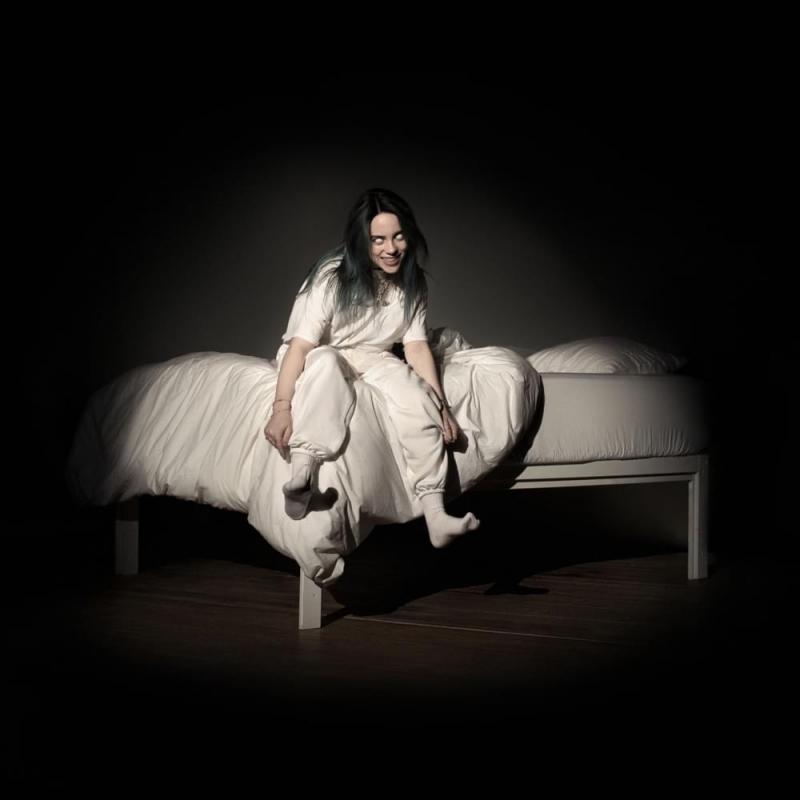CD: Billie Eilish - When We All Go To Sleep Where Do We Go? | reviews, news & interviews
CD: Billie Eilish - When We All Go To Sleep Where Do We Go?
CD: Billie Eilish - When We All Go To Sleep Where Do We Go?
A young star enters the hallucinatory cabaret tradition

Billie Eilish is a vaudevillian. Crack that and everything else falls into place.
It also puts her in a continuum of off-beam artistic conjurers, particularly of fellow Los Angelenos. Sure, as has been remarked plenty, you can hear her as a creative younger cousin to Lana Del Rey. But just as much, under the impossibly smooth electronic surfaces of Finneas's production, you can hear Tom Waits, David Lynch, James Ellroy, The Doors (the huge single “Bury a Friend” either consciously or unconsciously nods to “People are Strange”): all artists who live that sense of life being a cabaret (old chum), who blur the lines between archness and sincerity, theatrical mask and lived bohemianism. This isn't the “ta-daaaaa” off-Broadway cabaret of, say, Lady Gaga, or the exhausting pantomime of Amanda Palmer, it's real LA noir, smoky dive, mystery theatre.
But despite the hints of old timers (you can also hear strains of Bowie and White Album Beatles here, too), this is a groundbreaking record. The trap and avant-club sounds – with distortion and pinprick hi-def electronics, retro and sci-fi playing off one another like it's nothing – are done with as much deftness and playfulness as the crooning and jazz and sinister prowling. At points it recalls another cabaret pop auteur, Róisín Murphy (play "Bury a Friend" next to Murphy's 2005 "Night of the Dancing Flame"). And crucially, though the tunes are big and the voice and persona distinctive, it's sonically subtle: the frenzied crush of EDM and other 2010s pop is replaced by confident creation of space, where Billie can breathe and move and don one guise after another. Of course, she's young, she's privileged, it could all go to pot all too easily – but for now, let's enjoy this strange cabaret show by an extraordinary talent.
Watch the video for "Bad Guy":
rating
Explore topics
Share this article
The future of Arts Journalism
You can stop theartsdesk.com closing!
We urgently need financing to survive. Our fundraising drive has thus far raised £49,000 but we need to reach £100,000 or we will be forced to close. Please contribute here: https://gofund.me/c3f6033d
And if you can forward this information to anyone who might assist, we’d be grateful.

Subscribe to theartsdesk.com
Thank you for continuing to read our work on theartsdesk.com. For unlimited access to every article in its entirety, including our archive of more than 15,000 pieces, we're asking for £5 per month or £40 per year. We feel it's a very good deal, and hope you do too.
To take a subscription now simply click here.
And if you're looking for that extra gift for a friend or family member, why not treat them to a theartsdesk.com gift subscription?
more New music
 The Last Dinner Party's 'From the Pyre' is as enjoyable as it is over-the-top
Musically sophisticated five-piece ramp up the excesses but remain contagiously pop
The Last Dinner Party's 'From the Pyre' is as enjoyable as it is over-the-top
Musically sophisticated five-piece ramp up the excesses but remain contagiously pop
 Moroccan Gnawa comes to Manhattan with 'Saha Gnawa'
Trance and tradition meet Afrofuturism in Manhattan
Moroccan Gnawa comes to Manhattan with 'Saha Gnawa'
Trance and tradition meet Afrofuturism in Manhattan
 Soulwax’s 'All Systems Are Lying' lays down some tasty yet gritty electro-pop
Belgian dancefloor veterans return to the fray with a dark, pop-orientated sound
Soulwax’s 'All Systems Are Lying' lays down some tasty yet gritty electro-pop
Belgian dancefloor veterans return to the fray with a dark, pop-orientated sound
 Music Reissues Weekly: Marc and the Mambas - Three Black Nights Of Little Black Bites
When Marc Almond took time out from Soft Cell
Music Reissues Weekly: Marc and the Mambas - Three Black Nights Of Little Black Bites
When Marc Almond took time out from Soft Cell
 Album: Mobb Deep - Infinite
A solid tribute to a legendary history
Album: Mobb Deep - Infinite
A solid tribute to a legendary history
 Album: Boz Scaggs - Detour
Smooth and soulful standards from an old pro
Album: Boz Scaggs - Detour
Smooth and soulful standards from an old pro
 Emily A. Sprague realises a Japanese dream on 'Cloud Time'
A set of live improvisations that drift in and out of real beauty
Emily A. Sprague realises a Japanese dream on 'Cloud Time'
A set of live improvisations that drift in and out of real beauty
 Trio Da Kali, Milton Court review - Mali masters make the ancient new
Three supreme musicians from Bamako in transcendent mood
Trio Da Kali, Milton Court review - Mali masters make the ancient new
Three supreme musicians from Bamako in transcendent mood
 Hollie Cook's 'Shy Girl' isn't heavyweight but has a summery reggae lilt
Tropical-tinted downtempo pop that's likeable if uneventful
Hollie Cook's 'Shy Girl' isn't heavyweight but has a summery reggae lilt
Tropical-tinted downtempo pop that's likeable if uneventful
 Pop Will Eat Itself's 'Delete Everything' is noisy but patchy
Despite unlovely production, the Eighties/Nineties unit retain rowdy ebullience
Pop Will Eat Itself's 'Delete Everything' is noisy but patchy
Despite unlovely production, the Eighties/Nineties unit retain rowdy ebullience
 Music Reissues Weekly: The Earlies - These Were The Earlies
Lancashire and Texas unite to fashion a 2004 landmark of modern psychedelia
Music Reissues Weekly: The Earlies - These Were The Earlies
Lancashire and Texas unite to fashion a 2004 landmark of modern psychedelia

Add comment